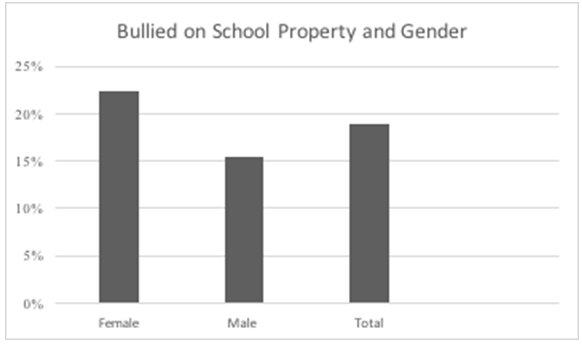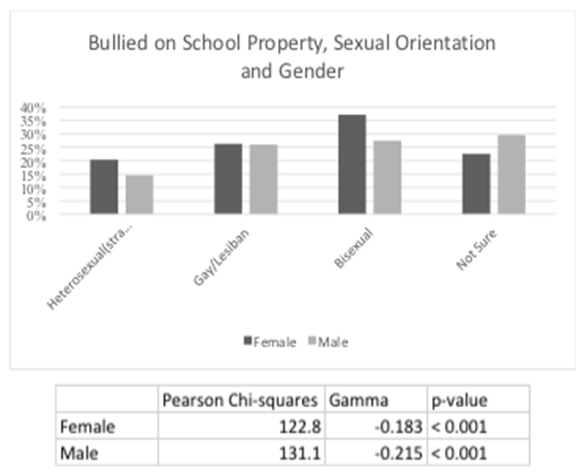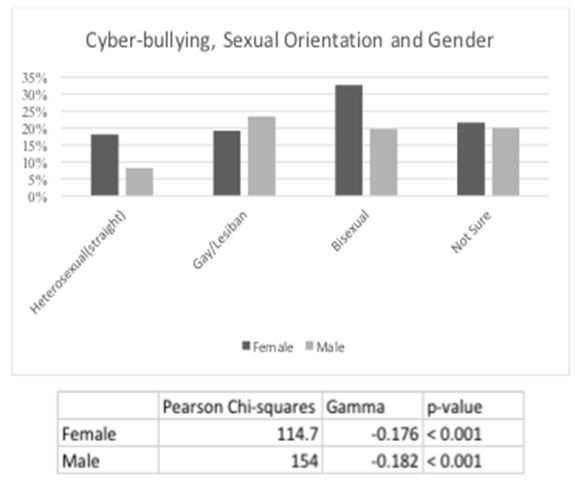-
Paper Information
- Paper Submission
-
Journal Information
- About This Journal
- Editorial Board
- Current Issue
- Archive
- Author Guidelines
- Contact Us
Public Health Research
p-ISSN: 2167-7263 e-ISSN: 2167-7247
2016; 6(6): 157-160
doi:10.5923/j.phr.20160606.02

Association of Sexual Orientation and Bullying among High School Students
Praphul Joshi, Mercedes Overton, Kayla Cole
Department of Health and Kinesiology, Lamar University, Beaumont TX, USA
Correspondence to: Praphul Joshi, Department of Health and Kinesiology, Lamar University, Beaumont TX, USA.
| Email: |  |
Copyright © 2016 Scientific & Academic Publishing. All Rights Reserved.
This work is licensed under the Creative Commons Attribution International License (CC BY).
http://creativecommons.org/licenses/by/4.0/

Bullying on school property as well as cyberbullying is a significant issue among high school students. Sexual minorities are more likely to be victims of bullying and name-calling. This study is based on a national survey of high school students (Youth Risk Behavior Survey – YRBS) regarding bullying and it’s correlation with sexual orientation (heterosexual, homosexual, bisexual and not-sure). Results of this study indicated that heterosexuals have the least likelihood of being bullied both on school property as well as online compared to homosexual and bisexual youth. Results also indicated that those who are still not sure about their sexual orientation are also more likely to be bullied. More emphasis should be given on mutual respect and future interventions should include bullying prevention efforts in high school, particularly discussing sexual orientation.
Keywords: Bullying, Cyber-bullying, School-bullying, Sexual Orientation, LGBTQ, Gender
Cite this paper: Praphul Joshi, Mercedes Overton, Kayla Cole, Association of Sexual Orientation and Bullying among High School Students, Public Health Research, Vol. 6 No. 6, 2016, pp. 157-160. doi: 10.5923/j.phr.20160606.02.
1. Introduction
- Many students nationwide are facing an issue that goes on in schools. Bullying leads to depression, anxiety, and is the leading cause of suicide among high school students. One out of every four students, which is 22% report being bullied during the school year [1]. In high School 64% of children who were bullied did not report it [2]. Each day different reports of bullying come into play whether it is about weight, race, or sexual orientation. In 2013, the reason for being bullied reported most often by students was due to looks, body shape and race [3]. Students who experience bullying are at an increased risk for poor school adjustment, sleep difficulties, anxiety, and depression [4].Bullying can be defined as relating to unwanted aggressive behavior, observed or perceived power balance, or repetition of behavior. Recent school bullying statistics show out of the 77 percent of those bullied, 14 percent have a severe or bad reaction to the abuse [5]. The students go through depression, anxiety, and even can become suicidal. Half of high school students fear bullying at school, mainly in school bathrooms [6]. Studies have shown that most common and violent alterations between students happen on school grounds. With 85% of students saying they have been bullied at school, no effort was given from a teacher or administration member to stop the bullying from happening [7].Since the use of technology continues to increase, so has the issue with cyber-bullying. Cyber-bullying sometimes referred to as “electronic bullying”, includes phones, emails, chat rooms, etc. Cyber-bullying involves primarily verbal, and relational aggression, that is, threatening, harassment, and spreading rumors. 19.6% of high school students in the U.S. report being bullied at school in the past year and 14.8% reported being bullied online [8]. Due to more students having mobile devices students have constant access to the internet. About 92% of students reported going online daily, of those 24% say they go online almost constantly [9]. With 90% of students who reported being cyber-bullied also say they are bullied offline as well [10]. Results from previous studies indicate that most students who get cyber-bullied also get bullied at school as well.Sexual orientation has always been an issue for Americans since the beginning of time. With people having different cultural beliefs and traditions it could be hard for a person to admit their sexual orientation. Sexual orientation has been a topic of discussion. As an adult socio-cultural issues with sexual orientation becomes easier to deal with. But with young adolescents the socio-cultural issues can be challenging to deal with. Students tend to bully other students who are not perceived to be “normal” as everyone else [9, 10]. The LGBTQ (lesbian, gay, bisexual, transsexual, questioning) community has been the prime targets in bullying. Among High School Students 81.9% of students who identified as LGBTQ were bullied in the last year based on sexual orientation [11]. With regard to safety, 63.5% of students feel unsafe because of their sexual orientation and 43.9% feel unsafe in schools because of their gender expression [11].
2. About the Study
- The main objectives of the study were: 1) to analyze the correlation between sexual orientation and bullying at school property among high school students; and 2) to analyze the correlation between sexual orientation and cyber-bullying. Gender differences with regard to bullying were alanyzed as well.
3. Methodology
- Researchers retrieved 2015 YRBS data, which was collected nationally from high school students 9th through 12th grade. The sample of the study include 15,624 students male and female which were evenly distributed. With regard to sexual orientation, it was categorized as Heterosexual (straight), Bisexual, Gay/Lesbian, and not sure. The age group of participants varied from 14-18 years old. Pearson Chi-squares, and Gamma coefficients were calculated to determine significant findings.
4. Results
- As shown in Figure 1, bullying on school property was significantly different across genders. Females were more likely to be bullied on school property than male students. The gender differences were statistically significant with Pearson Chi square = 191.1, Gamma = 0.197 and p<0.001.
 | Figure 1. Prevalence of Bullying on School Property by Gender |
 | Figure 2. Prevalence of Cyber-bullying by Gender |
 | Figure 3. Sexual orientation and bullying on school property |
 | Figure 4. Sexual orientation and cyber bullying |
 | Figure 5. Prevalence of bullying on school property by sexual orientation and gender |
 | Figure 6. Prevalence of cyber-bullying by sexual orientation and gender |
5. Discussion
- School is a place to get away from home and spend time with friends in a safe environment that is condusive of quality educational experience. However, some LGBTQ youth are more likely than their heterosexual peers to experience difficulties in their lives and school environments, such as violence. Negative attitudes toward lesbian, gay, and bisexual people put these youth at increased risk for experiences with violence, compared with other students [12]. Violence can include behaviors such as bullying, teasing, harassment, physical assault, and suicide-related behaviors. With no support from peers or family, lesbian gays and bisexuals have a high rate of bullying. According to data from Youth Risk Behavior Surveys (YRBS) conducted during 2001‒2009 in seven states and six large urban school districts, the percentage of lesbian / gay students (across the sites) who were threatened or injured with a weapon on school property in the prior year ranged from 12% to 28% [14]. High school students who are not really sure of their sexual orientation get more bullying than heterosexual students. Students who were questioning their sexual orientation reported more bullying, homophobic victimization, unexcused absences from school, drug use, feelings of depression, and suicidal behaviors than either heterosexual or lesbian / gay students.Reasoning of this high bullying rate amongst high school students is largely due to lack of acceptance. Being with same sex in a relationship is perceived to be “not right”. According to data from CDC’s YRBS, the percentage of gay, lesbian, and bisexual students (across sites) who did not go to school at least one day during the 30 days before the survey because of safety concerns ranged from 11% to 30% of gay and lesbian students and 12% to 25% of bisexual students [13].During adolescence, students tend to experience their first adult erotic feelings, experiment with sexual behaviors, and develop a strong sense of their own gender identity and sexual orientation [14]. Many may say those who are not sure of their sexual orientation are just confused, promiscuous, or don’t want anyone to know their sexual preference, which makes them very vulnerable towards bullying and name-calling.Based on this study, not sure category had a high likelihood of being bullied. Students who are not sure of their sexual orientation can be perceived as either confused about their sexual orientation, or not ready to admit the truth of their sexual orientation due to the fear of being bullied. For many people, admitting to themselves that they are gay, bisexual or lesbian can be challenging for many reasons. It could be because they have been brought up to think being gay is wrong, or because they are worried about being teased or bullied [15].In a random sample of high school health teachers, one in five surveyed said that students in their classes often used abusive language when describing homosexuals [16]. Also, a national study of secondary school counselors' perceptions of adolescent homosexuals found that 25 percent perceived that teachers exhibited significant prejudice toward homosexual students and that 41 percent believed that schools were not doing enough to help gay and lesbian students adjust to their school environments [16].
6. Conclusions
- This study showed significant differences in bullying due to sexual orientation among high school students. The results indicated those who were bisexual were more likely to be bullied whether on school property or cyber bullied with majority percentage being female students. Results also indicated that those who were unsure of their sexual orientation were likely to be bullied as well with being gay/lesbian not far behind. Still the highest percentage of bullying was towards the female gender. A student’s sexual orientation should not be a fear of being bullied. Schools and communities need to create interventions on bullying, specifically teaching mutual respect and acceptance of diverse cultures. New interventions should educate youth on how bullying can affect the life of adolescents physically and mentally and ways to prevent it from happening.
References
| [1] | US Department of Education, National Center for Educational Statistics (2015). Student Reports of Bullying and Cyberbullying: Results from the 2013 School Crime Supplement to the National Victimization Survey. Retrieved from: http://nces.ed.gov/pubsearch/pubsinfo.asp?pubid=2015056. |
| [2] | Petrosino, A., Guckenburg, S., DeVoe, J., & Hanson, T. Institute of Education Sciences, (2010). What characteristics of bullying, bullying victims, and schools are associated with increased reporting of bullying to school officials? Washington, D.C.: National Center for Education Evaluation and Regional Assistance. Retrieved from: http://ies.ed.gov/ncee/edlabs/regions/northeast/pdf/REL_2010092_sum.pdf. |
| [3] | Davis, S., & Nixon, C. (2010). The youth voice research project: Victimization and strategies. Retrieved from: http://njbullying.org/documents/YVPMarch2010.pdf. |
| [4] | Center for Disease Control, National Center for Injury Prevention and Control (2012). Understanding bullying. Retrieved from: http://www.cdc.gov/violenceprevention/pdf/bullyingfactsheet2012-a.pdf. |
| [5] | Kann, Laura, Steve Kinchen, and Shari Shanklin. "United States 2013 Results." High School Youth Risk Behavior Survey. Center for Disease Control, June 2014. Retrieved from: http://www.cdc.gov/mmwr/pdf/ss/ss6304.pdf. |
| [6] | Kann, Laura, Steve Kinchen, and Shari Shanklin. "United States 2013 Results." High School Youth Risk Behavior Survey. Center for Disease Control, June 2014. Retrieved from: http://www.cdc.gov/mmwr/pdf/ss/ss6304.pdf. |
| [7] | S.K. Telljohann, et al. (Jan.1995), p. 18; J.H. Price and S. K. Telljohann, "School Counselor's Perceptions of Adolescent Homosexuals," Journal of School Health, vol. 61, no. 10 (Dec. 1991), pp. 433-8. |
| [8] | Centers for Disease Control and Prevention. Sexual identity, sex of sexual contacts, and health-risk behaviors among students in grades 9-12—Youth Risk Behavior Surveillance, selected sites, United States, 2001-2009. MMWR. 2011. |
| [9] | Pew Reseacrh Center. (2015). Technology use amongst youth [Data file and code book]. Retrieved from http://pewresearch.org/datasets/. |
| [10] | Pew Research Center. (2015). Technology use amongst youth [Data file and code book]. Retrieved From http://pewresearch.org/datasets/. |
| [11] | Kosciw, J. G., Greytak, E. A., Bartkiewicz, M. J., Boesen, M. J., & Palmer, N. A. GLSEN, (2011). The 2011 national school climate survey. Retrieved from: 2011 National School Climate Survey Full Report.pdf. |
| [12] | Coker TR, Austin SB, Schuster MA. The health and health care of lesbian, gay, and bisexual adolescents. Annual Review of Public Health 2010; 31: 457–477. |
| [13] | Centers for Disease Control and Prevention. Sexual identity, sex of sexual contacts, and health-risk behaviors among students in grades 9-12—Youth Risk Behavior Surveillance, selected sites, United States, 2001-2009. MMWR. 2011. |
| [14] | Facing Facts: Sexual Health for America's Adolescents (New York: SIECUS, 1995), p. 12. |
| [15] | Together our voices are louder! (2015) Retrieved October 17, 2016 from http://www.stop.homophobia.com/comingout.htm |
| [16] | S.K. Telljohann, J.H. Price, M. Poureslami, A. Easton, "Teaching about Sexual Orientation by Secondary Health Teachers," Journal of School Health, vol. 65, no. 1 (Jan. 1995), pp. 18-22. |
 Abstract
Abstract Reference
Reference Full-Text PDF
Full-Text PDF Full-text HTML
Full-text HTML